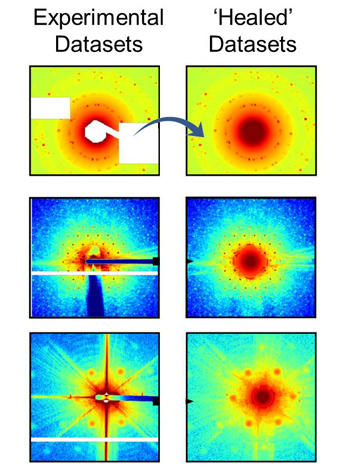Data Science Heals Imperfect X-ray Scattering Datasets
October 23, 2017
What is the scientific achievement?
The team of scientists developed and implemented a ‘physics-aware’ algorithm to correct for missing information in experimental X-ray scattering datasets. Because the algorithm relies on well-understood physics of X-ray scattering, the ‘healing’ operation provides robust and physically-rigorous results and outperforms all other conventional image interpolation methods.
Why does this achievement matter?
Experimental X-ray scattering images always contain missing data and artifacts, which complicate further analysis, especially rapid, automated analysis. This healing operation is an essential pre-processing step for machine-learning interpretation of scientific data.
What are the details?
Healing X-ray Images: X-ray scattering images have defects (left side), such as missing data and artifacts, which complicate analysis. A 'physics-aware' algorithm heals datasets in a physically-rigorous way (right side). enlarge
enlarge
CFN Capabilities:
Experiments to validate the healing algorithm were performed on the CMS beamline at NSLS-II — operated in partnership between CFN and NSLS-II.
Publication Reference
J. Liu, J. Lhermitte, Y. Tian, Z. Zhang, D. Yu, K. G. Yager, Healing X-ray Scattering Images, Journal of the International Union of Crystallography (IUCrJ) 4, 455 (2017).
DOI: 10.1107/S2052252517006212
Acknowledgement of Support
U.S. DOE Office of Science Facilities, operated at Brookhaven National Laboratory under contract no. DE-SC0012704
2017-12587 | INT/EXT | Newsroom









